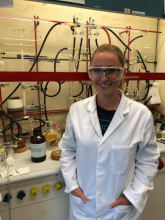
University:
Major:
Site Abroad:
Mentor(s):
Faculty Sponsor(s):
Faculty Sponsor's Department:
Project Title:
Project Description:
Supramolecular polymers are composed of monomeric units held together via reversible, directional, non-covalent interactions.1 Electricity, one of the most accessible stimuli in electronic devices, is not currently used to control these dynamic materials. A promising candidate for development of electro-responsive supramolecular polymers is the N,N’-bisubstituted 4,4’-bipyridinium, or “viologen”, platform. These redox agents are a subject of renewed interest due to their radical cationic state, which displays the interesting ability to form pi-bonded dimers in polar solvents.2 Their unique redox chemistry suggests that viologen compounds could utilize electrochemistry as a method of switching non-covalent interactions within supramolecular materials “on” and “off”. In this study, two new viologen compounds, a chiral amide derivative and a chiral urea derivative, were synthesized. The role of solvent polarity in chiral amide aggregation was studied with circular dichroism and UV-visible spectroscopy using varying ratios of chloroform and methanol. This analysis, combined with nuclear magnetic resonance spectroscopy and static light scattering, indicated that the unreduced monomer forms two different aggregates. Static light scattering measurements also suggested that the unreduced monomers form small, non-spherical aggregates in chloroform. UV-visible spectra confirmed the presence of the chemically reduced chiral amide radical cation, but further NMR and SLS studies must be employed to determine if redox-triggered aggregation occurs. The chiral urea derivative synthesized in this study is predicted to display similar aggregation of the unreduced monomer, which is unfavorable for the desired application in electro-responsive supramolecular polymers. Therefore, these materials would be best re-designed with increasingly polar side chains to discourage aggregation of the unreduced monomers.
- De Greef, T. F.; Smulders, M. M.; Wolffs, M.; Schenning, A. P.; Sijbesma, R. P.; Meijer, E. W. Chemical Reviews 2009, 109 (11), 5687-754.
- Geraskina, M. R.; Dutton, A. S.; Juetten, M. J.; Wood, S. A.; Winter, A. H. Angew. Chem. Int. Ed. 2017, 56 (32), 9435-9439.
